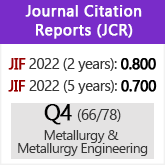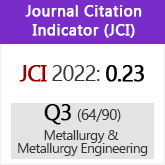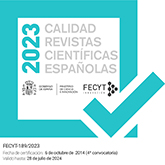Sel fpropagating high temperature synthesis (SHS) of the Fe(TiMo)C masteralloy using ferroalloys
DOI:
https://doi.org/10.3989/revmetalm.0820Keywords:
Carbides, SHS, Masteralloys, Ferroalloys, SteelAbstract
Titanium monocarbide TiC is very hard, stable both at high and low temperatures and relatively easy to synthesize from its constituent elements by SHS. Nevertheless, it is difficult to use, as alloying element, in the reinforcement of steels manufactured by liquid metallurgy due to its low wettability by molten steel. To achieve this purpose and due to its better wettability, it is more appropriate to use a master alloy formed by the complex carbide (TiMo)C bonded in Fe. The simplest and most economic way to fabricate such a master alloy Fe(TiMo)C is, again, by SHS, with the added advantage that it can be manufactured using the commercial ferroalloys FeTi and FeMo instead of the individual elements Fe, Ti and Mo. In this work, we describe such a process as well as the characteristics of the master alloy obtained.
Downloads
References
[1] H.W. Hugosson, Doctoral thesis in physics, Uppsala University, 2001.
[2] R.M. Hathaway, P.K. Rohatgi, N. Sobczak y J.Sobczak, Proc. Int. Conf. High Temperature Capillarity, Poland, 1997.
[3] Metal Matrix Alloys, Patente WO 93/03192 (1993).
[4] J.V. Wood, K. Dinsdale, P. Davies y J.L.F. Kellie, Mater. Sci.Technol. 11 (1995) 1.315-1.320.
[5] I. Agote, M. Gutierrez, M. Orbegozo, M. Asen - sio, J.I. Erauskin, L.A. Erausquin y J. Roncal,Rev. Metal. Madrid Vol. Extr. (2005) 53-57.
[6] Ch. K. Kim, L. Sunghak, J. Jae-Young y A. Sangho, Mater. Sci. Eng. 349 (2003) 1-11. doi:10.1016/S0921-5093(01)01850-0
[7] A.V. Koroteev, S.S. Ordan’’yan, É.V. Prilutskii y V.F. Litvinov, Powder Metall. Met. 25 (1986), 319-321. doi:10.1007/BF00794415
[8] U.A. Tamburini, F. Maglia, G. Spinolo y Z.A. Munir, Chim. Ind. (2000) 1-10.
[9] A.G. Merzhanov y A.E. Sytschev, http://www.ism.ac.ru/handbook/_shs.htm.
[10] M.J. Capaldi, A. Saidi y J.V. Wood, ISIJ Int. 37 (1997, released 2007) 188-193.
[11] S.R. Shatynski Oxid. Met. 13 (1979) 106.
[12] Departamento Metalurgia, Escuela de Ingenie - ros, San Sebastián, Energias libres de formación de carburos en función de la temperatura, 1972.
[13] R. Licheri, R. Orrú, G. Cao, A. Crippa y R. Scholz, Ceram. Int. 29 (2003) 519-526.
Downloads
Published
How to Cite
Issue
Section
License
Copyright (c) 2009 Consejo Superior de Investigaciones Científicas (CSIC)

This work is licensed under a Creative Commons Attribution 4.0 International License.
© CSIC. Manuscripts published in both the printed and online versions of this Journal are the property of Consejo Superior de Investigaciones Científicas, and quoting this source is a requirement for any partial or full reproduction.All contents of this electronic edition, except where otherwise noted, are distributed under a “Creative Commons Attribution 4.0 International” (CC BY 4.0) License. You may read here the basic information and the legal text of the license. The indication of the CC BY 4.0 License must be expressly stated in this way when necessary.
Self-archiving in repositories, personal webpages or similar, of any version other than the published by the Editor, is not allowed.


















